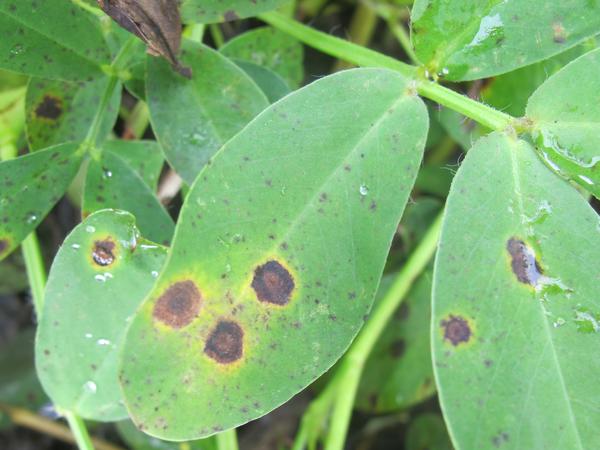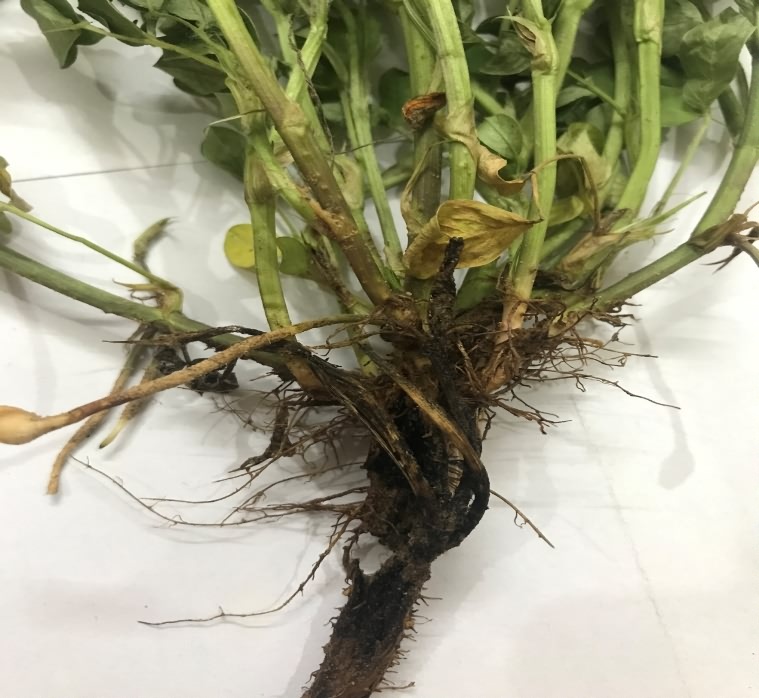मूंगफली के दो प्रमुख रोग और उसका प्रबंधन
1. Tikka disease of Groundnut
It is also called leaf spot disease of groundnut. It caused losses 20 to 50%.
Symptoms:
Based on the relative time of spot appearance, disease is categorized as (i) early leaf spot and (ii) late leaf spot and their comparative symptoms are as follows:
| Characters | Early leaf spot (ELS) | Late leaf spot (LLS) |
| Caused by fungus | Cercaspora arachidicola | Cercosporidium personatum |
| Perfect stage of pathogen | Mycosphaerella arachidicola | Mycosphaerella berkeleyli. |
| Time of spot appearance | After 3-4 weeks of sowing (on about one month old plants) | After 6-8 weeks of sowing (on about two month old plants) |
| Spot shape | Irregular or circular | Almost circular |
| Spot colour | Reddish brown to black on upper surface & light brown on lower surface. | Dark brown to black on both sides. |
| Spot size | Bigger (1 to 10 mm in diameter) | Smaller (1 to 6 mm in diameter) |
| Spot numbers | Less in number | More in number |
| Yellow halo | Spot surrounded by yellow halo. | Rarely or not surrounded by yellow halo |
| Danger and Loss | Less dangerous and loss is low | More dangerous and loss is high due to production of more spots, spread faster & cause defoliation earlier |
| Predominance | Dominant in North India | Dominant in South and central states. |
 Pathogen:
Pathogen:
- Cercospora arachidicala (Teleomorph or perfect stage "Mycosphaesrella archidicola) = ELS
- Cercosporidium personatum (teleomorph or perfect stage = M. berkeleyli) = LLS
Classification: According to Hawksworth et.al. 1995
Kingdom Fungi
Group Mitosporic fungi (Deuteromycetes)
Genus (i) Cercospora (ii) Cercosporidium
Species (i) archidicola (ii) personatum
Characters:
| Characters | Cercospora arachidicola | Cercosporidium personatum |
| Mycelium | Septate, inter- & intra- cellular | Septate, intercellular with haustoria |
| Conidiophores | Light olivaceous brown,Unbranched,Geniculate (knee-shaped)1-2 septate, thin & continuous. | Olivaceous brown,Unbranched,Geniculate (knee-shaped)1-2 septate & broad & continuous |
| Conidia | Sub-hyaline to light yellow.Obelavate with rounded base & sub acute tip.Thin & long4-12 septate. | Light colored.Obclavate to cylindrical with blunty rounded ends.Broad & short.1-7 septate |
Disease Cycle:
Pathogens are seed- (shells) & soil- borne in nature. Disease is polycyclic.
Survival:- Pathogen survive/perpetuate through conidia lying in the soil on diseased plant debris and carried in the shell (seed). Fungi also survive on volunteer plants.
Primary infection: Primary infection is caused (or ascospores but rarely) on leave carried out by wind or other agencies on lower leaves.
Secondary infection- Sec. infection on healthy plants in the same field or nearby fields caused by conidia produced on primary infected leaves.
Pre-disposing factors:- High RH, long low temp (20-30 ºC) & dew period. High nitrogen & phosphorous & deficiency of Mg are increase the disease incidence while potash decrease the incidence.
Management:
Cultural Practices:
- Remove crop residues & burn.
- Follow crop rotation with non-host crops.
- Deep burying of crop residues.
- Early sowing i.e. by alter the date of sowing (in June or earlier) escape from disease.
- Grow early maturing varieties.
Chemical Control:
1. Treat the seeds with copper sulphate solution (0.5%) for 30 min.
2. Spray the crop with either of following fungicides:
Bordeaux mixture (4:4:50=0.8% or 5:5:50=1%) (Copper fungicide by Millardet 1882, 1885).
Composition = copper sulphate (Toxic to fungi & bacteria) + lime + water zineb (0.25%), Mancozeb (0.25%).
Systemic fungicides = Carbendazim (0.1%), Benomyl (0.1%), cercobin (Thiophanate) Recently developed fungicides = Propiconazole (Tilt - 25EC), Chlorothalonil (Kavach - 25 EC) Difenoconazole (Score - 25 EC)
Resistant Varieties
- Grow var: G-0120, G-1032, G-0607, Exotic and genotypes like ICGV-891104 ^ ICGV-91114.
- Varieties having bushy foliage are less liable to damage than erect and foliated ones.
 2. Collar Rot Disease:
2. Collar Rot Disease:
It is also called "crown rot" disease of groundnut. Now it has become an important disease of groundnut. In India first reported by Jain & Nema (1952). In India, 50% loss has been reported by this disease.
Aflatoxin: A toxin (mycotoxin) produced by "Aspergillus flavus" in groundnut kernels which is toxic or poisonous to poultry birds & animals.
A-fla-toxin: A= Aspergillus; fla = flavus; toxin= poison)
Symptoms:
The symptoms consist of rotting of seeds, pre-emergence soft rot of the hypocotyls and post-emergence collar rot of the seedlings. Due to collar rot, there is girdling of the collar region & the leaves become chlorotic.
This is followed by drooping, wilting & death of the affected branches. The affected collar region becomes shredded, is soon covered with profuse and black growth of the fungus (spores).
Causal Organism: It also called mould & weed of laboratory (Aspergillus spp.)
Disease Cycle:
The pathogen is seed & soil-borne in nature.
Survival- It survives in infected plant debris lying in the soil and in seeds (under seed cost). Seed become infected during the last days of maturation in the soil and during harvest, handling & particularly during shelling.
Primary infection:- Mycelium and conidia cause primary infection at the collar region at any stage from sowing till crop maturity.
Pre-disposing factors:- Warm weather conditions (30-35ºC), application of high dose a nitrogenous fertilizers, light soils favor the pathogen. It can tolerate low soil moisture.
Management:
Cultural Practices:
- Always use good quality undamaged seeds.
- Collect & destroy infected plants.
- Maintain field sanitation.
- Follow crop rotation with non-host-crops (e.g. Wheat, gram)
- Adopt deep summer ploughing to kill soil borne pathogen.
- Adopt solar heating (soil solarization) during hot summer days by covering the soil with polythene sheet.
- Apply soil amendments like neem or castor cake (500 kg/la).
- Deep sowing should be avoided, as etiolated hypocotyls are more prone to infection (Adopt shallow sowing).
Chemical Control:
- (i) Treat the seeds with carbendazim @ 0.2% (e.i. 2g/kg seed) or Thiram (3 g/kg)
- (ii) Treat the seeds with fungal bio-control agent (BCA) Trichoderma harziamum or Trichoderma viride culture @ 4-10 g/kg seed.
- (iii) Also apply Trichoderma culture (BCA) into soil @ 4-10 kg/ha.
- (iv) Drench the crop with 0.1% solution (1g/litre) of carbendazim near root zone.
Resistant Var:- Grow resistant varieties to the disease.
Drenching- application of pesticides' solution into the soil or near by the root zone.
Authors:
Yadav* and R. P. Ghasolia**
*Assistant professor, Department of Plant Pathology, College of Agriculture, Bikaner
** Associate Department of Plant Pathology,SKN College of Agriculture, Bikaner
Email:
